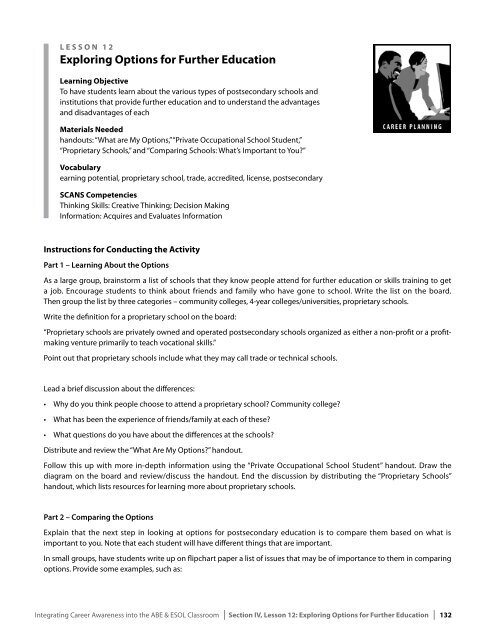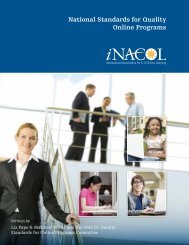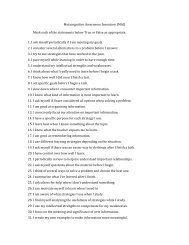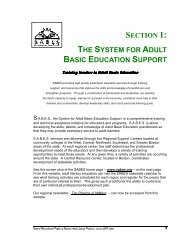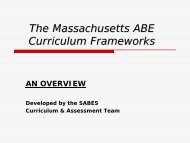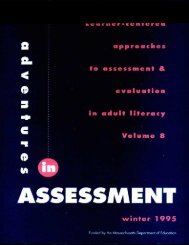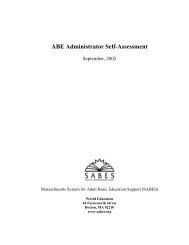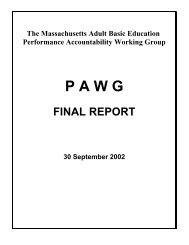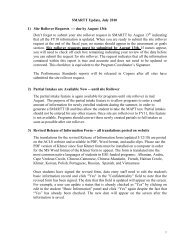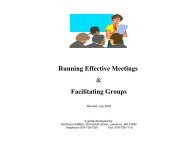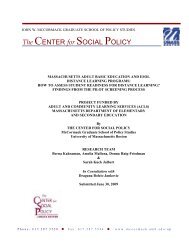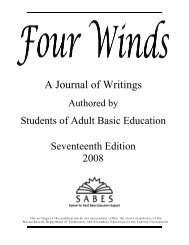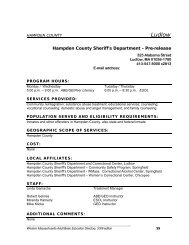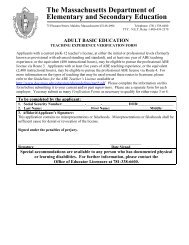Integrating Career Awareness into the ABE/ESOL Classroom - SABES
Integrating Career Awareness into the ABE/ESOL Classroom - SABES
Integrating Career Awareness into the ABE/ESOL Classroom - SABES
- No tags were found...
Create successful ePaper yourself
Turn your PDF publications into a flip-book with our unique Google optimized e-Paper software.
L e s s o n 1 2<br />
Exploring Options for Fur<strong>the</strong>r Education<br />
Learning Objective<br />
To have students learn about <strong>the</strong> various types of postsecondary schools and<br />
institutions that provide fur<strong>the</strong>r education and to understand <strong>the</strong> advantages<br />
and disadvantages of each<br />
Materials Needed<br />
handouts: “What are My Options,” “Private Occupational School Student,”<br />
“Proprietary Schools,” and “Comparing Schools: What’s Important to You?”<br />
Vocabulary<br />
earning potential, proprietary school, trade, accredited, license, postsecondary<br />
SCANS Competencies<br />
Thinking Skills: Creative Thinking; Decision Making<br />
Information: Acquires and Evaluates Information<br />
Instructions for Conducting <strong>the</strong> Activity<br />
Part 1 – Learning About <strong>the</strong> Options<br />
As a large group, brainstorm a list of schools that <strong>the</strong>y know people attend for fur<strong>the</strong>r education or skills training to get<br />
a job. Encourage students to think about friends and family who have gone to school. Write <strong>the</strong> list on <strong>the</strong> board.<br />
Then group <strong>the</strong> list by three categories – community colleges, 4-year colleges/universities, proprietary schools.<br />
Write <strong>the</strong> definition for a proprietary school on <strong>the</strong> board:<br />
“Proprietary schools are privately owned and operated postsecondary schools organized as ei<strong>the</strong>r a non-profit or a profitmaking<br />
venture primarily to teach vocational skills.”<br />
Point out that proprietary schools include what <strong>the</strong>y may call trade or technical schools.<br />
Lead a brief discussion about <strong>the</strong> differences:<br />
• Why do you think people choose to attend a proprietary school? Community college?<br />
• What has been <strong>the</strong> experience of friends/family at each of <strong>the</strong>se?<br />
• What questions do you have about <strong>the</strong> differences at <strong>the</strong> schools?<br />
Distribute and review <strong>the</strong> “What Are My Options?” handout.<br />
Follow this up with more in-depth information using <strong>the</strong> “Private Occupational School Student” handout. Draw <strong>the</strong><br />
diagram on <strong>the</strong> board and review/discuss <strong>the</strong> handout. End <strong>the</strong> discussion by distributing <strong>the</strong> “Proprietary Schools”<br />
handout, which lists resources for learning more about proprietary schools.<br />
Part 2 – Comparing <strong>the</strong> Options<br />
Explain that <strong>the</strong> next step in looking at options for postsecondary education is to compare <strong>the</strong>m based on what is<br />
important to you. Note that each student will have different things that are important.<br />
In small groups, have students write up on flipchart paper a list of issues that may be of importance to <strong>the</strong>m in comparing<br />
options. Provide some examples, such as:<br />
<strong>Integrating</strong> <strong>Career</strong> <strong>Awareness</strong> <strong>into</strong> <strong>the</strong> <strong>ABE</strong> & <strong>ESOL</strong> <strong>Classroom</strong> | Section IV, Lesson 12: Exploring Options for Fur<strong>the</strong>r Education | 132


